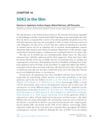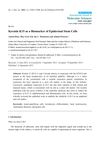TLDR Stem cells play a key role in nonmelanoma skin cancers, with different origins and genetic changes linked to basal and squamous cell carcinomas.
The document discussed the role of stem cells in nonmelanoma skin cancers, specifically squamous cell carcinoma (SCC) and basal cell carcinoma (BCC). It highlighted that SCC and BCC are clonal, while focal hyperplasias are polyclonal. Stem cells in the skin, particularly those in the hair follicle bulge, were identified as multipotent, capable of differentiating into various epidermal cells. BCCs were linked to follicular bulge stem cells and genetic changes in the Sonic Hedgehog pathway, while SCCs could originate from stem cells in different skin compartments, including the interfollicular epidermal proliferative unit (EPU). The study also noted that genetic or epigenetic changes in stem cell markers, such as integrins and telomerase, were associated with squamous cell neoplasms.
315 citations
,
June 2001 in “Nature Genetics” 338 citations
,
April 2001 in “Current Biology” c-Myc activation in mouse skin increases sebaceous gland growth and affects hair follicle development.
949 citations
,
January 2001 in “Cell” Adult mouse skin contains stem cells that can create new hair, skin, and oil glands.
1010 citations
,
August 2000 in “Cell” Hair follicle stem cells can form both hair follicles and skin.
166 citations
,
July 1999 in “American Journal Of Pathology” 467 citations
,
May 1999 in “Molecular Cell” Activating c-Myc in skin causes rapid cell growth and changes, but these effects are reversible.
318 citations
,
October 1998 in “The Journal of Cell Biology” Keratin 17 is important for skin development and may help define skin cell types.
153 citations
,
April 1998 in “Current Biology” The risk of skin tumors becoming malignant depends on the specific skin cell type affected.
441 citations
,
May 1996 in “Journal of Cell Science” Keratin 19 helps identify skin stem cells, with its presence varying by body location, age, and culture stage.
 77 citations
,
January 1980 in “Carcinogenesis”
77 citations
,
January 1980 in “Carcinogenesis” TPA is about 50 times more effective at promoting tumors than MZ.
 1 citations
,
September 2015 in “Elsevier eBooks”
1 citations
,
September 2015 in “Elsevier eBooks” SOX2 is crucial for skin cell function and hair growth, and it plays a role in skin cancer and wound healing.
 85 citations
,
September 2013 in “International Journal of Molecular Sciences”
85 citations
,
September 2013 in “International Journal of Molecular Sciences” Keratin 15 is not a reliable sole marker for identifying epidermal stem cells because it's found in various cell types.
178 citations
,
April 2011 in “Journal of Clinical Investigation” Basal cell carcinomas in mice can start from hair follicle stem cells and other skin cell types, depending on signaling levels.
36 citations
,
March 2011 in “Stem Cell Reviews and Reports” 164 citations
,
February 2010 in “Journal of Cell Science” Human dermal stem cells can become functional skin pigment cells.
503 citations
,
May 2009 in “Cell stem cell” Lrig1 marks a unique group of stem cells in mouse skin that can become different skin cell types.
42 citations
,
October 2006 in “Theriogenology” Porcine skin cells are useful for studying wound healing and cancer.


